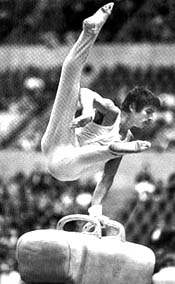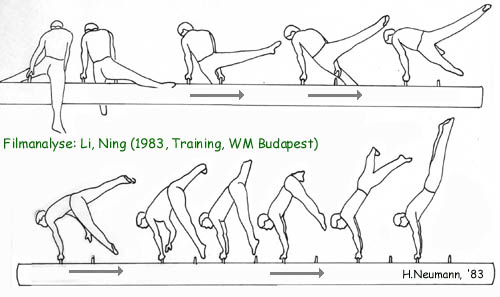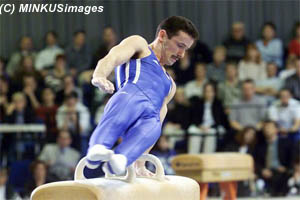| . |
| The
1970s - The Magyar Years |
|
|

Zoltan Magyar
|
Hungarian pommel
horse virtuoso Zoltan Magyar
heavily contributed to the development of pommel horse work
Further structural improvements to the horse facilitated these
developments.
It would take a few more years
for the old name "side horse" to make way for "pommel
horse". The "Magyar spindle" is to this day
a specifically Hungarian element of the highest difficulty
which is rarely shown.
The innovation of the Thomas
flairs, which had actually been performed by Canadian Delesalle
before Kurt Thomas
(USA) at the 1976 Olympics, was a sensation. Soon, gymnasts
started constructing entire routines from this type of elements,
forcing the FIG's technical committee to put a stop to this
by changing the code of points.
|
| The
1980s -cultivation of the Thomas flairs |
Gymnasts
used Thomas flairs in any possible variation in their routines. Combined
with handstands, turns in handstand, they still remain one of the most
common dismount combinations to this day.
| |

Swings
in the straddled position were brought to handstand by most
gymnasts in the early 1980s.
Li Ning showed a spectacular
front scissor with ¼ turn. But fear of possibly pausing in handstand
and the ensuing deductions stood in the way of an inflation
of such elements.
|
|
| The
1990s spindles with turns |
The
first half of the 1990s was marked by the flaired spindles with 1/2
turns and the full spindle in one or two circles. These were missing
from hardly any top routine. Gymnasts began showing various support
positions on the apparatus.
When
these elements were downgraded, they disappeared from most routines.
| A
new millennium of gymnastics no more flops |
The
new rules no longer allow the endless combinations of bonus
elements, like the "quadruple flop" which generated
0,6 in bonus alone. Only one flop is allowed now (immediate
Stoeckli B on one pommel, 0,2 in bonus). The maximum bonus
for this is now 0,3 (instead of the previous 1,1 pts).
Autor: Heinz Neumann,
Potsdam;
(Bearbeitung und Gestaltung: E.Herholz, GYMmedia)
|

Marius Urzica - the "pommel
artist" of the Nineties.
|
|




